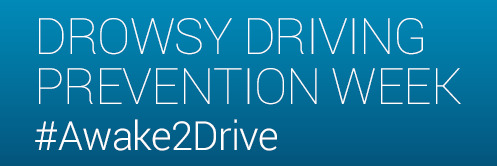
Safety News

Drivers are Falling Asleep Behind the Wheel
According to the Centers for Disease Control and Prevention, about 1 in 25 adult drivers report having fallen asleep while driving, and many more admit to driving when they were sleep deprived.
These startling figures show how prevalent drowsy driving is. What drivers may not realize is how much drowsy driving puts them – and others – at risk. In fact, an estimated 6,400 people die annually in crashes involving drowsy driving, according to the National Sleep Foundation.
Impact of Drowsiness on Driving
Driving while drowsy is similar to driving under influence of alcohol:
● Drivers’ reaction times, awareness of hazards and ability to sustain attention all worsen the drowsier the driver
● Driving after going more than 20 hours without sleep is the equivalent of driving with a blood-alcohol concentration of 0.08% – the U.S. legal limit
A driver might not even know when he or she is fatigued because signs of fatigue are hard to identify. Some people may also experience micro-sleep – short, involuntary periods of inattention. In the 4 or 5 seconds a driver experiences micro-sleep, at highway speed, the vehicle will travel the length of a football field.
Prevalence of Drowsy Driving Crashes
It’s difficult to know how many drowsy-driving crashes occur each year, as it is difficult to determine whether a driver was drowsy at the time of a crash. The National Highway Traffic Safety Administration estimated that in 2017, about 100,000 police-reported, drowsy-driving crashes result in nearly 800 fatalities and about 50,000 injuries.
A study by the AAA Foundation for Traffic Safety estimated that 328,000 drowsy driving crashes occur annually, more than three times the police-reported number. The same study found that 109,000 of those drowsy driving crashes resulted in an injury and about 6,400 were fatal. The researchers suggest the prevalence of drowsy driving fatalities is more than 350% greater than reported.
Beyond the human toll is the economic one. NHTSA estimates fatigue-related crashes resulting in injury or death cost society $109 billion annually, not including property damage.
Interventions for Drowsy Driving
Drowsy driving affects everyone, including adolescents and teens. The Centers for Disease Control and Prevention recommends teens get eight to 10 hours of sleep each night. Interventions focusing on this age group can help move the needle to reduce drowsy driving. One such intervention is for parents to incorporate discussions and rules on drowsy driving while completing their parent-teen driving agreements.
Other ways to reduce drowsy driving include:
● Crash-avoidance technologies: Safety technologies such as drowsiness alert and lane departure warnings can detect common drowsy driving patterns and warn drivers to stay in their lane or take a break
● University interventions: College students receive less than average sleep, with some estimates at less than six hours a night; education programs aimed at college students may help curb drowsy driving and instill healthier behaviors that can last into adulthood
● Getting more sleep: According to the American Academy of Sleep Medicine and the Sleep Research Society, adults should get seven or more hours of sleep each night
● Medication labels: An article by Consumer Reports found that side-effect warnings are not always clear; new labeling guidelines may help drivers understand when to drive or not drive after taking these medications
● Employer action: Workplaces with strong off-the-job safety and health programs can include key information on getting sufficient sleep and refraining from drowsy driving
Too Tired to Drive?
The following are signs and symptoms of drowsy driving, according to the American Academy of Sleep Medicine:
● Frequent yawning or difficulty keeping your eyes open
● Nodding off or having trouble keeping your head up
● Inability to remember driving the last few miles
● Missing road signs or turns
● Difficulty maintaining your speed
● Drifting out of your lane

